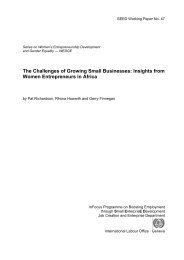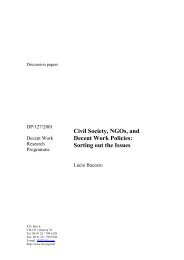Nepal Trafficking in Girls With Special Reference to Prostitution: A ...
Nepal Trafficking in Girls With Special Reference to Prostitution: A ...
Nepal Trafficking in Girls With Special Reference to Prostitution: A ...
Create successful ePaper yourself
Turn your PDF publications into a flip-book with our unique Google optimized e-Paper software.
A Rapid Assessment<br />
3.3 <strong>Traffick<strong>in</strong>g</strong>-Prone Areas<br />
Contemporary processes of traffick<strong>in</strong>g have spread throughout <strong>Nepal</strong>. The respondents <strong>in</strong> this study came<br />
from 29 districts cover<strong>in</strong>g all ecological zones and development regions of the country. A majority were born <strong>in</strong><br />
the central hills/mounta<strong>in</strong>s (35/85). Three-fourths (64/85) reported birthplaces <strong>in</strong> rural areas of <strong>Nepal</strong>. The<br />
majority of respondents are from the follow<strong>in</strong>g districts: S<strong>in</strong>dhupalchowk (n=7), Nuwakot (n=7), Chitwan (n=7),<br />
Kathmandu (n=5), Rupandehi (n=5), Banke (n=5) and Lalitpur (n=5) (Table 3.1).<br />
3.3.1 High Risk Groups<br />
Although the phenomenon of traffick<strong>in</strong>g crosses many caste/<br />
ethnic group divisions, those most at risk are the hill ethnic<br />
groups and lower castes. In the survey sample, the majority<br />
came from hill ethnic groups (47%) followed by Brahm<strong>in</strong>/<br />
Chhetri (3/17= 23.5%), Dalits (17.7%) and Terai groups<br />
(11.8%). In terms of <strong>in</strong>dividual caste/ethnicity, the highest<br />
number were Tamang, followed by Chhetri (Table 3.2).<br />
The previously mentioned study by the Society<br />
Protection Youth Club Ichowk, S<strong>in</strong>dhupalchowk, which<br />
is a typical traffick<strong>in</strong>g prone district, also supports the<br />
evidence that Tamang girls are much more affected than<br />
other castes/ethnic groups. Of 73 girls trafficked from 61<br />
households, 72 were from the Tamang community. Most<br />
key <strong>in</strong>formants also highlighted the over representation of<br />
Table 3.2: Trafficked <strong>Girls</strong> by Caste/Ethnicity<br />
Trafficked/Commercial Sexual Exploitation<br />
Caste/Ethnicity N Caste/Ethnicity N<br />
Hill Groups 40 (47.1) Dalits 15 (11.8)<br />
Tamang 24 Kamai 9<br />
Magar 7 Damai 6<br />
Gurung 3 Terai 10 (11.8)<br />
Rai 2 Sardar 3<br />
Bhujel 2 Saha 3<br />
Kumal 1 Kahar 2<br />
Newar 1 Tharu 2<br />
Brahm<strong>in</strong>/Chhetri 20 (23.5)<br />
Chhetri 17<br />
Brahm<strong>in</strong> 3 Total 85<br />
3.3.2 Age When Trafficked<br />
Numbers <strong>in</strong> parentheses <strong>in</strong>dicate percentages.<br />
Tamangs. However,<br />
one key <strong>in</strong>formant<br />
reported that<br />
Chhetri girls from<br />
Western <strong>Nepal</strong> are<br />
also very affected<br />
by the phenomenon<br />
of traffick<strong>in</strong>g. Thus,<br />
it would be mistaken<br />
<strong>to</strong> conclude<br />
that only Tamang<br />
girls are trafficked<br />
and/or are at high<br />
risk.<br />
The respondents were trafficked from early adolescence (Table 3.3). About one-fourth were under fourteen, and<br />
more than half were under sixteen. In our sample, girls were seldom trafficked before puberty - about age thirteen.<br />
Table 3.3: Age When First Trafficked<br />
Age when first trafficked N Per cent Cum. per cent<br />
9 1 1.5 1.5<br />
10 1 1.5 3.0<br />
11 1 1.5 4.5<br />
12 2 3.0 7.5<br />
13 11 16.4 23.9<br />
14 10 14.9 38.8<br />
15 10 14.9 53.7<br />
16 14 20.9 74.6<br />
17 15 22.4 97.0<br />
18 2 3.0 100.0<br />
Total 67 100.0<br />
Mean age 15<br />
1 7

















